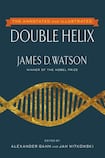
On April 25th, 1953, James Watson and Francis Crick of the Cavendish Laboratory, at Cambridge University, published their proposal of the double helix, a model of the structure of DNA, the chemical of which genes are made. Their discovery ranks with that of natural selection by Darwin and Wallace as the most important in biology. Watson and Crick's model of DNA explained the chemical basis of heredity and of evolution.
The model showed how the sequence of four chemical units, the bases, arranged in a long but simple, polymeric molecule of DNA, could accommodate the great diversity of genetic information. The bases are the letters of the genetic language. They are arranged in two helical strands as a sequence of so-called base pairs. The model suggested how the sequence might replicate and mutate.
The double helix corresponded to the aperiodic crystal imagined by Erwin Schrödinger in his lectures in the physics theatre at Trinity College Dublin in 1943, entitled What I s Life? Watson and Crick sent a copy of their paper to him, acknowledging his influence on their interest in the chemical structure of genes.
The model was based on a range of evidence, including X-ray crystallography, produced by Maurice Wilkins and Rosalind Franklin at King's College London. The Cambridge and King's groups were competing with each other, but they talked and, sometimes, co-operated. The genetic predictions of the model were proven by the work of Meselson and Stahl on DNA replication and Kornberg on base pairing. Wilkins later went on to produce beautiful X-ray data, confirming the overall model with some modifications. The precise structure was verified by Dickerson in 1980; by then DNA was changing the world.
Watson likes to contrast a scientific discovery with a work of art, a book or a musical composition. A scientific discovery is there to be made, whereas the others are unique creations. Even if the discovery was itself a highly creative process, someone would have discovered the double helix. But it might have taken a lot more time and Watson would not have been the person to write about it.
No one can write what Watson has written. His first great success was his textbook The Molecular Biology of the Gene (1965), a joy to read, with pithy arguments, in elegant, simple text, illustrated by novel diagrams. It is now in its seventh edition. Many others followed including, recently, Avoid Boring People .
In 1968 he published The Double Helix , one of the most successful descriptions of how science is actually done. By the rather stuffy academic standards of the time, it was a frank, cavalier description of the race for DNA. Watson defended it as an accurate picture of how he and others behaved. When the race began he was 23 and as interested in tennis and girls as he was in genetics. Crick was by any standards a character, brilliant, irrepressible, irreverent and effervescent, and the two sparked off each other and everyone else as they wrestled with their ideas. The Double Helix was not boring and it is still a great read.
It was on the New York Times bestseller list and was nominated as one of the "88 books that shaped America" by the Library of Congress. It became a focus for feminists, who considered Rosalind Franklin to have been portrayed most unfairly; many believe her two years of work on DNA was much more significant than she was given credit for.
Other people tend to overlook Maurice Wilkins, who started the X-ray work on DNA in 1950. He produced the first detailed X-ray pictures that showed him, and later Watson and Crick, that the molecule had a relatively simple structure. It was Wilkins (with Alexander Stokes) who realised that DNA was helical, an idea that was sturdily resisted by Franklin. Watson found the real explanation for the base pairing, and Crick realised that the two strands ran in opposite directions in the helix. Wilkins declined an offer from Crick to be an author on the paper.
In 1962, Watson, Crick and Wilkins shared the Nobel Prize in Medicine. Crick’s letter of March 1953 to his 12-year-old son starts: “Jim Watson and I have probably just made a most important discovery.” The letter has just been sold for $6 million, with half of the money donated to the Salk Institute.
Franklin made sense of the transitions between A and B forms of DNA, and produced the exquisite Photograph 51, now in all textbooks and possibly the most famous X-ray photo ever taken. Watson credits her with “superb” X-ray work, especially the demonstration that the phosphate atoms are on the outside of the helix. The molecular biologist Struther Arnott suggests that Watson and Crick did not need this photo for their model: once they had the base pairs and the idea of two anti-parallel strands, they would probably have got the model from what they knew about A DNA, provided by Wilkins in 1951. Watson himself says that the new photo was most valuable in deciding on the overall dimensions of the model. Would Franklin have received a Nobel prize had she lived? Her life was tragically cut short in 1958, by cancer, at the age of 37, four years before the prize.
The Double Helix remains a brilliant and, thankfully, still controversial book, probably because "like nothing else, it gives one the feel of how creative science actually happens", as CP Snow wrote in his review of the first edition. The latest annotated edition tells us more, using some newly found letters between Watson and Crick. There are fascinating appendices, many reproductions of letters and delightful photographs of the participants in this thoroughly human story. (Scientists liked the Mediterranean and parties, and they still do.)
The new material fills out the story. It can be read in conjunction with Brenda Maddox's Rosalind Franklin: The Dark Lady of DNA (2002) and Wilkins's sensitive apologia Maurice Wilkins: The Third Man of the Double Helix (2003). Wilkins is clear that he was given Photograph 51 with Franklin's knowledge; Franklin's supporters claimed it was taken.
Sixty years of DNA will be celebrated at the National Botanic Gardens, in Dublin, this weekend when James Watson unveils a dramatic public sculpture, ?What is Life? , by Charles Jencks. With new emphasis on DNA's partner in genetics, RNA, the sculpture will remind us of the extraordinary impact of DNA and RNA on medicine (human insulin, numerous new anti-cancer drugs, the new vaccine against cervical cancer, rapid methods for diagnosing bacterial infections); on agriculture (more than 80 per cent of soy and 65 per cent of cotton plantings are genetically modified, and most cheese is made with genetically modified rennet); on forensic science (forensic DNA); and, above all, on the study of biology (just think that it has shown us that our most recent common ancestral group of antecedents lived in Africa 200,000 years ago).
The sculpture will be a focus for the educational programmes at the National Botanic Gardens. Like Watson’s book, it should encourage people to wonder about science and life.
It is also intended to recall the Irish strand in DNA. JD Bernal, from Co Tipperary, was an important figure in X-ray work on large biomolecules at the Cavendish from 1923 to 1937. Wilkins was taught by Bernal, and his parents and grandparents were from a society “of liberal Protestant intellectuals”, many, like his father, Trinity graduates. We now know his ancestors go back at least four generations in Ireland. And there was Schrödinger. And Watson’s maternal great-grandparents were Gleasons from Tipperary or Clare.
David McConnell is professor of genetics at Smurfit Institute of Genetics, Trinity College Dublin. John Atkins is research professor in the department of biochemistry, University College Cork.











